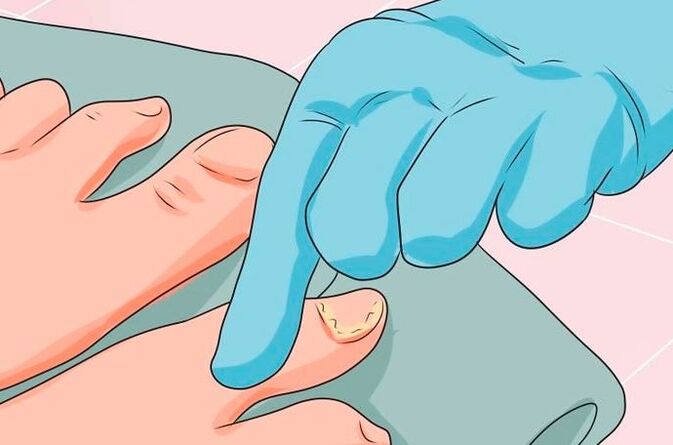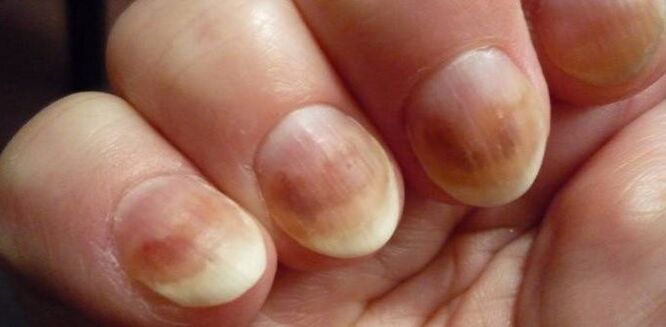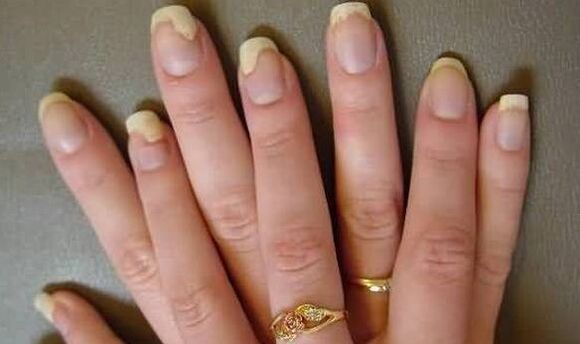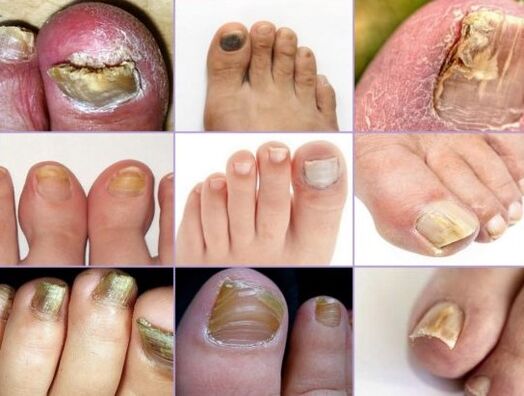Onychomycosis is a fungal damage to the nail plate. The disease can be caused by dermatophy fungi or microsporia. The fungus adversely affects the base of the nail construction - keratin and, gradually eating it, cause changes in deformation.

The following types of onychomycosis exist:
Normotorophical. Changing the color of the nail, the appearance of lines and stains.
Hypertrophic. Not only the color change occurs, but also a slight deformity. Most often, the nail is deformed by the edges.
Onikolytic. The nail is destroyed, atrophied and rejected.
The fungus on the nails of the legs appear not only because of a decrease in immunity. About 70% of people are infected by a patient, and most often they are a relative. Smaller skin stairs from the feet fall into household items and, in contact with healthy nails or skin, infect a healthy person.
Most often, the infection occurs through:
Washing clothes.
Sponges.
Towels.
Carpets.
Shoes.
Manicure accessories.
When visiting the beach, sauna and bathrooms without slippers, there is a high risk of infection with a fungus. With humidity and high fever, the infection occurs much more often.
Especially especially attentive to being in public places where people go barefoot. The fungus is resistant to low and high temperatures, and in the beach sand they maintain their durability for several months.
Healthy tissue is gradually affected by a fungus. Much depends on the type of pathogen, but some signs allow us to discern some major stages of development of onychomycosis:
Normotorophyte, or initial. There are no pronounced manifestations, at this stage it is difficult to notice infection with a fungus. The nail becomes more mature, its color can change slightly, small cracks occur, irregularities on the surface. Burning and itching can be felt. This period is easy to confuse with other diseases: psoriasis, liver changes. Therefore, to confirm the diagnosis, it is recommended to contact a dermatologist.
The hypertrophic form arises if the measures are not taken at the initial stage. Symptoms are becoming more pronounced. The nail thickens and darkens, the shape of the plate is deformed, it is destroyed and destroyed.
Atrophic, or neglected. It seems when the infection extends to the cuticle, the latter rejects, inflammation and swell. The entire surface of the nail plate changes its color, it is completely separated from the bed. Treatment can be ineffective, the nail is not always stored because of its atrophy.

Nail mushroom signs:
The nail plate begins to change the shade, it becomes dull. As a result, it loses a healthy pink color. When the mushrooms parasitize on the surface, the nail becomes white or yellow. So more often happens on the fingers. With other types of damage, the nail can take any shade: from green, gray to black.
Thickness or exhaustion of the nail plate - when you notice that the nail thickness has changed, this is a clear sign of fungal damage. At the same time, the nail plate loses elasticity, becomes harsh, tough or vice versa very soft, begins to destroy. The normal thickness of the nail on the fingers does not exceed 0. 5 mm, legs up to 1 mm.
Stratification of the nail plate, its delay behind the surface of the nail bed is a sign of the advanced stage of the disease when the nail structure changes. It becomes loose, uneven, covered with furrows.
An embarrassment - to realize that a fungus has appeared on the nails from the unpleasant sensations that accompany the disease. There is a severe itching, sometimes painful sensations.
An unpleasant odor - this symptom is particularly characteristic of onycomycosis on the finger nails. When they begin to smell unpleasantly, despite regular behavior of hygiene procedures, you should see a doctor.
Nail fungi are often associated with an extremely unpleasant odor
The general symptoms of the disease are listed above. But how specifically onycomycosis manifests itself depends on the type of fungus, which impressed the nail plate.
Each variety of mycosis has typical signs:
Fleet mushrooms - leads to rapid thinning of the nail plate. It becomes broken, begins to exterminate from the nail bed. The nail shade first becomes yellow, and then acquires a brown color. In a neglected form of the disease, the skin around the nails swells, reds.
Molds - parasitize on the surface of the nail plate, without penetrating deeper. Thanks to this, this type of disease is easier to treat than the rest. The main sign of the disease is a change in nail color. The shade can be any: from white, green to gray, black. If you do not start the correct treatment in a timely manner, the fungus spreads to other nails and even the skin. There is severe itching, pain, especially when walking.
Dermatophyte - develops when the nail is affected by trichophyton spp. , As well as Epidermophyton SPP and Microsporum spp. The first signs of this disease - stains or stripes of gray shadow, yellow are formed on the nail plate. As the disease progresses, their amount increases and the nail begins to exterminate.

Dermatophyte one of the usual forms of nail fungus
Knowing what kind of mold was hit by the nail very important for the correct treatment. The active components of most pharmacological drugs are designed to destroy a specific type of fungus.
Onychomycosis begins with the lesion of the trivial parts of the nail, so many people initially pay no attention to a change in shade and point formation. In the absence of treatment, mycosis spreads quite quickly, affecting all large areas of the infected nail, passing on healthy nails and infecting others.
There are 3 stages of nail mycosis development:
Initial stage - persists without clearly expressed symptoms, unpleasant sensations, such as itching, pain, often missing. Small dots, stripes, interspets that are barely distinguished appear on the nail plate. It is easier to notice them on your thumb.
The second or progressive phase of onycomycosis - the number of points and grooves increases, they become large and already visible. The color of the nail plate changes, it fades and begins to deform.
The advanced stage - the nail plate completely loses the aesthetic appearance, is too thick or very fragile. The nail color becomes yellow, brown, green, black. It extracts, there is a risk of complete nail loss.The first signs of the nail mushroom presence
The earlier it is possible to detect onycomycosis, the higher the probability of getting rid of this disease quickly. With competent operational therapy, the body suffers minimally, so when the first symptoms of mycosis appear, you should consult a doctor.
The first signs of nail mycosis appear almost immediately after the infection. If after visiting public places like a swimming pool, a sauna, a shower in the gym, the beach, the nails faded, they began to itch a little, then these may be the first signs of onycomycosis.
Healthy nails are virtually non -sensitive to infection with a fungus. It starts to develop rapidly when only on damaged nail plates.
Folk remedies
There are many popular remedies that will help cure nails affected by a fungus in the initial stage. Consider effective, but at the same time simple recipes.
Sometimes ordinary iodine can quickly help cope with fungi
Iodine - daily until the symptoms disappear, apply 1 5% iodine drop on the affected nails. The procedure is performed in the morning as well as in the evening. More material in relation to iodine treatment.
1 teaspoon of iodine, vinegar, glycerin mix and dilute with 6 teaspoons of water. The resulting mixture for 10 days in a row rubs the nails. The composition on the nail plate should be left overnight.
Vinegar - prepare a bath by diluting 1 part 9% vinegar with 8 parts hot water. Fly to her legs or arms for 20 minutes. Perform 7 procedures every other day. More material regarding the treatment of vinegar.
Ointment from the egg - put a raw chicken egg in the shell in a glass and pour 9%vinegar on top. When the shell dissolves, remove the remaining film and mix the egg with vinegar. The resulting mixture is applied twice daily to the affected areas for 2-3 weeks.
Ointment from chicken eggs is also quite effective against nail mycosis

Hydrogen Peroxide - diluted 2 liters of water 2 tablespoons hydrogen peroxide 3%. To fly hands or feet, depending on where the fungus is located for 20 minutes. Repeat the procedure for 7-10 consecutive days.
Peroxide compress - to satiate a cotton swab with peroxide, attach it to the nails on which there are signs of fungi. Before that, the arms or legs should be scared in the soda bath. To prepare it, 1 teaspoon soda is diluted in 1 liter of water. The compresses on top are wrapped in cellophane or food film and left for 60 minutes. This is necessary so that the peroxide does not evaporate. Repeat the procedure for 10-14 days twice daily.
Propolis tincture - moisten a cotton swab in the 20% propolis alcohol solution and glue it to the affected areas. Keep the lotion while the composition dries. Repeat daily until healing. Procedures 1-2 are enough per day.
Washing powder - the method is suitable for treating nails. It is necessary to dissolve 100 g of washing powder, which contains a lot of alkali, in 2 liters of water. Hold in such a bath for 15 minutes. Repeat the 10-14 procedures while the symptoms disappear.
Garlic - Cut a chopped garlic clove, wet in salt and then chop the nail plate. Repeat twice a day before the symptoms disappear.
Ammonia - diluted in 1 cup of water 1 tablespoon of ammonia. The resulting solution is saturated with cotton fabric. You have to wrap your legs or arms and leave this compression at night. Repeat the procedure for 7 days a day.
Onions - grind the onion to wild consistency and glue the affected nails for 30 minutes. Repeat twice daily before healing.
Chopped onions will help you turn your nails a healthy look
Mix chamomile, sage mint, you can get dry or fresh herbs. Place the resulting composition in a toe or handle at night. Plants should be changed every evening. Repeat the procedure in combination with other recipes while the fungal symptoms disappear.
Boric acid - cotton swabs saturated with boric acid are applied to predetermined nails. You need to keep lotion for 30 minutes. The procedure is repeated 10 days every day.
 Cerandin oils and tea wood - mix these products in an even proportion, absorb the gauze bandage with the resulting composition and apply on nails for 20 days in a row for 45 minutes. The recipe is contraindicated in pregnant women.
Soda - dilute soda with a small amount of water in wild consistency. Apply it on the nails for 20 minutes, and then rinse with warm water for 10-12 days twice a day.
Apple cider vinegar - dilute it with olive oil. The required percentage is 2 part of the vinegar in 1 part of the oil. Apply the mixture to the affected nail plates as the nail is growing completely.
Tea tree oil - apply a few drops of oil on the nails, while the nail plate areas affected by the fungus will grow completely.
Verba - Grind 500 g seedlings of a new shell, pour 2 liters of water, bring to a boil. From the finished cooking three times a week, make the baths for the hands or feet for 20 minutes until healing.
Nettle - create 3 tablespoons of charm in 400 ml of water. With this decoction, take wet tampons and apply them to the nail plates twice daily before healing.
Grind the mountain ash leaves and place on the nails with a thick layer, and then wrap with a baking film for 30 minutes. Repeat the procedure daily 12-14 days.
Cerandin oils and tea wood - mix these products in an even proportion, absorb the gauze bandage with the resulting composition and apply on nails for 20 days in a row for 45 minutes. The recipe is contraindicated in pregnant women.
Soda - dilute soda with a small amount of water in wild consistency. Apply it on the nails for 20 minutes, and then rinse with warm water for 10-12 days twice a day.
Apple cider vinegar - dilute it with olive oil. The required percentage is 2 part of the vinegar in 1 part of the oil. Apply the mixture to the affected nail plates as the nail is growing completely.
Tea tree oil - apply a few drops of oil on the nails, while the nail plate areas affected by the fungus will grow completely.
Verba - Grind 500 g seedlings of a new shell, pour 2 liters of water, bring to a boil. From the finished cooking three times a week, make the baths for the hands or feet for 20 minutes until healing.
Nettle - create 3 tablespoons of charm in 400 ml of water. With this decoction, take wet tampons and apply them to the nail plates twice daily before healing.
Grind the mountain ash leaves and place on the nails with a thick layer, and then wrap with a baking film for 30 minutes. Repeat the procedure daily 12-14 days.
Foot fungus.
Reduction of immunity.
Family members suffering from loss of fungi.
Old age.
Diabetes.
Presence of microtra and burrs.
Increased foot sweating.
Unknown and weak shoes of a quality.
The custom of walking barefoot in public places.
Accommodation and work in a wet climate.
Long transportation lined with artificial nails.
General health.
Sensitivity to infection.
Level of humidity and thermal background.
The type of nail plate (nails on the fingers grow more slowly).
Distal submarine onychomycosis.
Side onycomycosis.
Onikomycosis of the white surface.
Onycomycosis of proximal trays.
Total dystrophic onycomycosis.
How can you get an infection with a fungus?
Infection with nail mycosis can happen anywhere: from the places of public visit to your home. It is transmitted directly from humans to people as well as through objects with which a person suffering from Micosis contacts. The mushrooms penetrate micrococks, bruises, other damage.

Places in which you can become infected with mycosis:
Public places where people often go barefoot, especially if moisture grows there. In such a microclimate, Mikoz preserves life for a long time. Examples of such institutions are souls in fitness centers, saunas, baths.
Dresses in shops, sports complexes and other places.
Manicure Rooms - If the master does not process the tools poorly after having a manicure or pedicure per person with a fungus, there is a very high probability that the other client is infected with this disease.
Visiting and at home - when a person puts clothes, shoes where the mushrooms remained, uses a towel he had previously used by onycomycosis. The mushrooms can be on the nails if you walk barefoot on the floor.
Beach - in the sand on the beach there are always many fungal disputes. If you walk barefoot, they will penetrate micrococks and diseases cannot be avoided. In addition, you can get infected on the beach through a sun.
Public transport - through the handrails that the patient affected.
Store - while trying the naked foot of the shoe, which previously measured the patient with a nail fungus.
There are excellent chances of getting infected with a nail fungus in public transport
In the above countries, you need to be extremely neat to avoid infection.
























